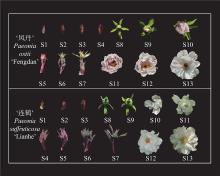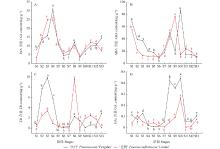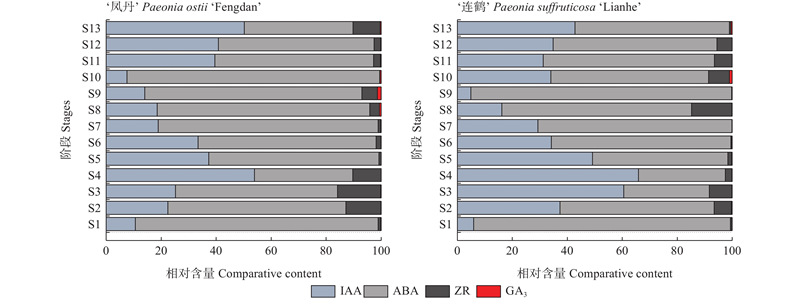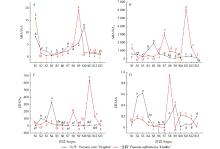

林业科学 ›› 2025, Vol. 61 ›› Issue (10): 26-37.doi: 10.11707/j.1001-7488.LYKX20240633
• 前沿热点 • 上一篇
王朵朵1,2,魏冬峰2,3,郭琪1,2,李昱莹1,2,杨雪婷1,2,牛童非1,2,张楠楠1,2,侯小改1,2,*( )
)
收稿日期:2024-10-26
出版日期:2025-10-25
发布日期:2025-11-05
通讯作者:
侯小改
E-mail:hkdhxg@haust.edu.cn
基金资助:
Duoduo Wang1,2,Dongfeng Wei2,3,Qi Guo1,2,Yuying Li1,2,Xueting Yang1,2,Tongfei Niu1,2,Nannan Zhang1,2,Xiaogai Hou1,2,*( )
)
Received:2024-10-26
Online:2025-10-25
Published:2025-11-05
Contact:
Xiaogai Hou
E-mail:hkdhxg@haust.edu.cn
摘要:
目的: 探究不同花型牡丹成花过程中表型及理化指标动态变化,为牡丹成花品质的提升及花型改良提供理论依据。方法: 以单瓣型品种‘凤丹’和菊花型品种‘连鹤’成花过程中13个不同发育阶段的花芽(朵)为试验材料,采用形态结构观测和植物生理学测定方法,分析不同花型牡丹成花过程中的外部形态和相关重要生理生化指标[吲哚乙酸(IAA)、脱落酸(ABA)、玉米素核苷(ZR)、赤霉素(GA3)、可溶性糖、可溶性蛋白、超氧化物歧化酶(SOD)、过氧化物酶(POD)]的动态变化情况。结果: ‘凤丹’和‘连鹤’的花芽(朵)自越冬鳞芽期至盛开期在宽度和高度上均呈不同程度增长,二者分别在大风铃期和小风铃期开始快速增长,且均在盛开期达到峰值。从初开期到盛开期,‘凤丹’的ZR含量升高,‘连鹤’的ZR含量持续下降。‘凤丹’和‘连鹤’的可溶性糖和可溶性蛋白含量变化趋势一致,但‘凤丹’的可溶性糖和可溶性蛋白含量从平桃期起始终高于‘连鹤’。‘凤丹’和‘连鹤’在破绽期的SOD活性相较于前一阶段均表现出增长趋势,随着发育继续进行,‘凤丹’的SOD活性呈先升高后降低的趋势,‘连鹤’的SOD活性则呈先降低后升高的趋势。‘凤丹’和‘连鹤’不同发育阶段花芽(朵)中的POD活性变化趋势基本一致,但在变动幅度上略有差异。结论: 大风铃期至盛开期为‘凤丹’的快速生长期,小风铃期至盛开期为‘连鹤’的快速生长期。高含量的IAA和低含量的ABA、GA3可促进‘凤丹’和‘连鹤’花朵绽放,高水平的ABA/IAA、ABA/GA3和低水平的ZR/IAA、ZR/GA3可能更有利于牡丹花芽打破休眠,萌动膨大期和圆桃期各种激素波动程度较大。‘凤丹’和‘连鹤’花芽中营养物质含量、抗氧化酶活性最高的阶段为萌动膨大期。小风铃期是不同品种牡丹向不同花型进行差异分化的关键阶段。
中图分类号:
王朵朵,魏冬峰,郭琪,李昱莹,杨雪婷,牛童非,张楠楠,侯小改. 不同花型牡丹成花过程中表型及理化指标动态变化[J]. 林业科学, 2025, 61(10): 26-37.
Duoduo Wang,Dongfeng Wei,Qi Guo,Yuying Li,Xueting Yang,Tongfei Niu,Nannan Zhang,Xiaogai Hou. Dynamic Changes in Phenotype and Physicochemical Indexes during the Flowering Process of Tree Peony with Different Flower Types[J]. Scientia Silvae Sinicae, 2025, 61(10): 26-37.

图1
2种牡丹不同发育阶段的花芽(朵) S1:越冬鳞芽期 Overwintering bud;S2:萌动膨大期 Budding stage;S3:显蕾期 Bud-squaring stage;S4:翘蕾期 Bud-sticking stage;S5:立蕾期 Bud-standing stage;S6:小风铃期 Small-bell stage;S7:大风铃期Big-bell stage;S8:圆桃期 Circular peach stage;S9:平桃期 Flat peach stage;S10:破绽期 Blooming stage;S11:初开期 Initial flowering stage;S12:半开期 Half opening stage;S13:盛开期 Full blooming stage."

表1
不同发育阶段花芽(朵)大小的动态变化($ \bar {\mathit{x}} $±s,n=9)①"
| 阶段 Stages | ‘凤丹’ Paeonia ostii ‘Fengdan’ | ‘连鹤’ Paeonia suffruticosa ‘Lianhe’ | |||
| 芽(花)宽 Width of bud (flower) | 芽(花)高 Height of bud (fiower) | 芽(花)宽 Width of bud (flower) | 芽(花)高 Height of bud (fiower) | ||
| S1 | 7.31±0.19g | 16.50±0.75i | 8.31±0.57h | 17.94±0.58h | |
| S2 | 8.28±0.20g | 19.30±0.87hi | 9.48±0.23gh | 22.67±2.13g | |
| S3 | 8.49±0.23g | 20.13±0.06hi | 9.72±0.22gh | 24.42±1.28fg | |
| S4 | 9.34±0.07g | 21.07±1.19h | 10.21±0.19gh | 25.83±0.81fg | |
| S5 | 13.49±0.72fg | 25.57±0.87g | 12.15±0.39g | 26.52±1.79fg | |
| S6 | 16.07±0.42f | 31.37±2.77f | 16.07±0.42f | 27.92±2.28f | |
| S7 | 17.43±0.22f | 31.68±1.03f | 18.11±0.68f | 35.71±0.85e | |
| S8 | 28.14±0.46e | 40.30±1.50e | 25.97±0.30e | 39.22±1.54e | |
| S9 | 29.99±1.03e | 45.32±3.58d | 29.27±0.16d | 44.68±2.71d | |
| S10 | 38.56±0.80d | 49.57±3.09c | 38.83±0.51c | 50.54±1.71c | |
| S11 | 48.75±0.82c | 53.03±1.84bc | 49.55±0.34b | 52.82±2.14c | |
| S12 | 107.03±4.82b | 55.46±0.55b | 54.36±1.26b | 58.32±0.89b | |
| S13 | 182.97±8.39a | 82.84±0.89a | 170.50±4.24a | 77.52±3.33a | |

图2
不同发育阶段激素变化情况 IAA:吲哚乙酸 Indole acetic acid;ABA:脱落酸 Abscisic acid;ZR:玉米素核苷 Zeatin riboside;GA3:赤霉素 Gibberellic acid. S1:越冬鳞芽期 Overwintering bud;S2:萌动膨大期 Budding stage;S3:显蕾期 Bud-squaring stage;S4:翘蕾期 Bud-sticking stage;S5:立蕾期 Bud-standing stage;S6:小风铃期 Small-bell stage;S7:大风铃期Big-bell stage;S8:圆桃期 Circular peach stage;S9:平桃期 Flat peach stage;S10:破绽期 Blooming stage;S11:初开期 Initial flowering stage;S12:半开期 Half opening stage;S13:盛开期 Full blooming stage.同一品种不同小写字母表示该品种不同阶段之间存在显著差异(P<0.05)。Different lowercase letters of the same variety indicated that there were significant differences between different stages of the variety(P<0.05)."


图3
不同发育阶段4种激素所含比例 IAA:吲哚乙酸 Indole acetic acid;ABA:脱落酸 Abscisic acid;ZR:玉米素核苷 Zeatin riboside;GA3:赤霉素 Gibberellic acid.S1:越冬鳞芽期 Overwintering bud;S2:萌动膨大期 Budding stage;S3:显蕾期 Bud-squaring stage;S4:翘蕾期 Bud-sticking stage;S5:立蕾期 Bud-standing stage;S6:小风铃期 Small-bell stage;S7:大风铃期Big-bell stage;S8:圆桃期 Circular peach stage;S9:平桃期 Flat peach stage;S10:破绽期 Blooming stage;S11:初开期 Initial flowering stage;S12:半开期 Half opening stage;S13:盛开期 Full blooming stage."


图4
不同发育阶段激素比值变化情况 IAA:吲哚乙酸 Indole acetic acid;ABA:脱落酸 Abscisic acid;ZR:玉米素核苷 Zeatin riboside;GA3:赤霉素 Gibberellic acid. S1:越冬鳞芽期 Overwintering bud;S2:萌动膨大期 Budding stage;S3:显蕾期 Bud-squaring stage;S4:翘蕾期 Bud-sticking stage;S5:立蕾期 Bud-standing stage;S6:小风铃期 Small-bell stage;S7:大风铃期Big-bell stage;S8:圆桃期 Circular peach stage;S9:平桃期 Flat peach stage;S10:破绽期 Blooming stage;S11:初开期 Initial flowering stage;S12:半开期 Half opening stage;S13:盛开期 Full blooming stage.同一品种不同小写字母表示该品种不同阶段之间存在显著差异(P<0.05)。Different lowercase letters of the same variety indicated that there were significant differences between different stages of the variety(P<0.05)."


图5
不同发育阶段可溶性糖、可溶性蛋白含量变化情况 S1:越冬鳞芽期 Overwintering bud;S2:萌动膨大期 Budding stage;S3:显蕾期 Bud-squaring stage;S4:翘蕾期 Bud-sticking stage;S5:立蕾期 Bud-standing stage;S6:小风铃期 Small-bell stage;S7:大风铃期Big-bell stage;S8:圆桃期 Circular peach stage;S9:平桃期 Flat peach stage;S10:破绽期 Blooming stage;S11:初开期 Initial flowering stage;S12:半开期 Half opening stage;S13:盛开期 Full blooming stage.同一品种不同小写字母表示该品种不同阶段之间存在显著差异(P<0.05)。Different lowercase letters of the same variety indicated that there were significant differences between different stages of the variety(P<0.05)."


图6
不同发育阶段SOD、POD活性变化情况 S1:越冬鳞芽期 Overwintering bud;S2:萌动膨大期 Budding stage;S3:显蕾期 Bud-squaring stage;S4:翘蕾期 Bud-sticking stage;S5:立蕾期 Bud-standing stage;S6:小风铃期 Small-bell stage;S7:大风铃期Big-bell stage;S8:圆桃期 Circular peach stage;S9:平桃期 Flat peach stage;S10:破绽期 Blooming stage;S11:初开期 Initial flowering stage;S12:半开期 Half opening stage;S13:盛开期 Full blooming stage.同一品种不同小写字母表示该品种不同阶段之间存在显著差异(P<0.05)。Different lowercase letters of the same variety indicated that there were significant differences between different stages of the variety(P<0.05)."

| 毕愿坤, 李 丽, 朱传应, 等. 生境、温度及外源激素对花花柴花器官发育的影响. 生物技术通报, 2021, 37 (4): 28- 34. | |
| Bi Y K, Li L, Zhu C Y, et al. Effects of habitat, temperature and exogenous hormones on the organ development of Karelinia caspia. Biotechnology Bulletin, 2021, 37 (4): 28- 34. | |
| 卜文轩, 姚奕平, 黄 宇, 等. ‘呼红’牡丹高温胁迫响应生理与转录组分析. 园艺学报, 2024, 51 (12): 2800- 2816. | |
| Bu W X, Yao Y P, Huang Y, et al. Transcriptome analysis of the response of tree peony ‘Huhong’ underhigh temperature stress. Acta Horticulturae Sinica, 2024, 51 (12): 2800- 2816. | |
| 蔡 燕, 吴 顺. 丹参不同生长时期叶片内抗氧化酶活性的比较研究. 热带农业工程, 2023, 47 (4): 143- 145. | |
| Cai Y, Wu S. A comparative study on antioxidant enzyme activities in the leaves of Salvia miltiorrhiza at different growth stages. Tropical Agricultural Engineering, 2023, 47 (4): 143- 145. | |
|
陈庭巧, 董晓晓, 袁 涛, 等. 单花、有侧花牡丹品种花芽分化特点及内源激素变化. 广西植物, 2023, 43 (2): 368- 378.
doi: 10.11931/guihaia.gxzw202111068 |
|
|
Chen T Q, Dong X X, Yuan T, et al. Flower bud differentiation characteristics and endogenous hormone changes of in single and lateral-flowered tree peony (Paeonia Sect. Moutan) cultivars. Guihaia, 2023, 43 (2): 368- 378.
doi: 10.11931/guihaia.gxzw202111068 |
|
| 陈小红, 韦 莉, 黄玉琼, 等. 鸳鸯茉莉花色变化过程中的生理生化特性研究. 植物科学学报, 2018, 36 (4): 595- 602. | |
| Chen X H, Wei L, Huang Y Q, et al. Study on the physiological and biochemical characteristics of Brunfelsia acuminata petals during flowering. Plant Science Journal, 2018, 36 (4): 595- 602. | |
| 杜立言, 郑 娜, 李静静, 等. 樱花品种‘十月樱’花芽分化期内源激素含量变化. 森林与环境学报, 2021, 41 (1): 51- 59. | |
| Du L Y, Zheng N, Li J J, et al. Changes in endogenous hormones during flower bud differentiation in Cerasus subhirtella ‘Autumnalis’. Journal of Forest and Environment, 2021, 41 (1): 51- 59. | |
| 范瑾怡, 张莹婷, 吴文菁, 等. 2种石蒜属植物不同生育期内源激素含量变化. 分子植物育种, 2022, 20 (19): 6550- 6558. | |
| Fan J Y, Zhang Y T, Wu W J, et al. Changes of endogenous hormones in 2 kinds of Lycoris plants at different growth stages. Molecular Plant Breeding, 2022, 20 (19): 6550- 6558. | |
| 高 康. 2021. 菊花花型关键性状的全基因组关联分析. 北京: 北京林业大学. | |
| Gao K. 2021. Genome-wide association studies on key traits of chrysanthemum flower type. Beijing: Beijing Forestry University. [in Chinese] | |
| 郭群艳, 刘彩贤, 余秋岫, 等. 紫花含笑花发育过程中生理和内源激素的变化. 园艺学报, 2024, 51 (8): 1881- 1890. | |
| Guo Q Y, Liu C X, Yu Q X, et al. Studies on the physiological indexes and endogenous hormones variation during flower development in Michelia crassipes. Horticultural Plant Journal, 2024, 51 (8): 1881- 1890. | |
| 和志娇, 杨雅涵, 和加卫, 等. 2024. 3个蓝莓品种花芽分化特性比较研究. 中国果树, (9): 48−56. | |
| He Z J, Yang Y H, He J W, et al. 2024. Comparative study on the flower bud differentiation characteristics of three blueberry varieties. China Fruits, (9): 48−56. [in Chinese] | |
| 冀含乐, 王茜赟, 马会萍, 等. 2024. 牡丹花茎全长转录组测序分析及花茎发育相关基因分析. 分子植物育种, https://link.cnki.net/urlid/46.1068.S.20240508.1557.010. | |
| Ji H L, Wang Q Y, Ma H P, et al. 2024. Full-length transcriptome sequencing of peony flower stem and analysis of genes related to flower stem development. Molecular Plant Breeding, https://link.cnki.net/urlid/46.1068.S.20240508.1557.010. [in Chinese] | |
| 李 波, 夏秀英, 刘 思. 蓝莓花芽休眠与解除过程中生理生化变化及DNA甲基化差异分析. 植物生理学报, 2015, 51 (7): 1133- 1141. | |
| Li B, Xia X Y, Liu S. Changes in physiological and biochemical properties and variation in DNA methylation patterns during dormancy and dormancy release in blueberry (Vaccinium corymbosum L.). Plant Physiology Journal, 2015, 51 (7): 1133- 1141. | |
| 李合生. 2000. 植物生理生化实验原理和技术. 北京: 高等教育出版社. | |
| Li H S. 2000. Principles and techniques of plant physiological and biochemical experiments. Beijing: Higher Education Press. [in Chinese] | |
|
李俊男, 燕晓杰, 李枢航, 等. 植物AUX/IAA基因家族研究进展. 中国农学通报, 2018, 34 (15): 89- 92.
doi: 10.11924/j.issn.1000-6850.casb18010021 |
|
|
Li J N, Yan X J, Li S H, et al. Plants AUX/IAA gene family research progress. Chinese Agricultural Science Bulletin, 2018, 34 (15): 89- 92.
doi: 10.11924/j.issn.1000-6850.casb18010021 |
|
| 李燕娇, 吴建明, 周慧文, 等. 植物赤霉素生物合成关键基因GA3-oxidase的研究进展. 分子植物育种, 2022, 20 (16): 5339- 5346. | |
| Li Y J, Wu J M, Zhou H W, et al. Research progress on gibberellin biosynthesis key gene GA3-oxidase in plants. Molecular Plant Breeding, 2022, 20 (16): 5339- 5346. | |
|
李志娟, 贾民隆, 吕英民, 等. 萱草花芽分化过程中内源激素的动态变化. 山西农业科学, 2021, 49 (9): 1061- 1066.
doi: 10.3969/j.issn.1002-2481.2021.09.08 |
|
|
Li Z J, Jia M L, Lü Y M, et al. Dynamic changes of endogenous hormone during floral bud differentiation in Hemerocallis. Journal of Shanxi Agricultural Sciences, 2021, 49 (9): 1061- 1066.
doi: 10.3969/j.issn.1002-2481.2021.09.08 |
|
| 刘瑞琳. 2023. 西伯利亚杏延迟开花的生理生化特性研究. 沈阳: 沈阳农业大学. | |
| Liu R L. 2023. Physiological and biochemical characteristies of delayed flowering in Armeniaca sibirica. Shenyang: Shenyang Agricultural University. [in Chinese] | |
| 刘 茜. 2014. 不同菊花品种开花过程中花瓣表面形态变化与生理变化比较. 开封: 河南大学. | |
| Liu X. 2014. Comparative studies on changes of morphological and physiological in different chrysanthemum varieties during flowering. Kaifeng: Henan University. [in Chinese] | |
| 刘兴巧, 马晓蕾, 马慧丽, 等. 氮肥喷施时间对‘凤丹’牡丹小枝生物量分配及养分利用的影响. 林业科学, 2024, 60 (12): 47- 57. | |
| Liu X Q, Ma X L, Ma H L, et al. Effects of nitrogen spraying time on the biomass allocation and nutrient utilization of Paeonia ostii ‘Fengdan’ twigs. Scientia Silvae Sinicae, 2024, 60 (12): 47- 57. | |
|
刘银萍. ‘洛阳红’花期花瓣抗氧化酶SOD、POD和CAT活性的研究. 河南林业科技, 2020, 40 (3): 13- 15.
doi: 10.3969/j.issn.1003-2630.2020.03.004 |
|
|
Liu Y P. The study of antioxidants of ‘Luoyanghong’ on petals about SOD、POD、CAT during florescences. Journal of Henan Forestry Science and Technology, 2020, 40 (3): 13- 15.
doi: 10.3969/j.issn.1003-2630.2020.03.004 |
|
| 牛童非, 薛 娴, 郭丽丽, 等. 2023 外源茉莉酸甲酯对温室牡丹‘洛阳红’挥发性成分及含量的影响. 林业科学, 59(5): 53−60. | |
| Niu T F, Xue X, Guo L L, et al. 2023. Effects of exogenous methyl jasmonate on volatile components and content of Paeonia suffruticosa ‘Luoyanghong’ in greenhouse. Scientia Silvae Sinicae, 59(5): 53−60. [in Chinese] | |
| 覃喜军, 黄夕洋, 蒋水元, 等. 罗汉果花芽分化过程中内源激素的变化. 植物生理学通讯, 2010, 46 (9): 939- 942. | |
| Qin X J, Huang X Y, Jiang S Y, et al. Changes in endogenous hormones during floral bud differentiation of Siraitia grosvenorii (Swingle) C. Jeffrey. Plant Physiology Communications, 2010, 46 (9): 939- 942. | |
|
孙苗苗, 张 蔚, 张林霞, 等. 矮牵牛花朵大小遗传规律及相关基因的表达分析. 植物学报, 2024, 59 (3): 422- 432.
doi: 10.11983/CBB23141 |
|
|
Sun M M, Zhang W, Zhang L X, et al. Genetic rules of flower size and expression analysis of related genes in petunia. Chinese Bulletin of Botany, 2024, 59 (3): 422- 432.
doi: 10.11983/CBB23141 |
|
| 王 辉, 孙耀清, 杨 乐, 等. 3种茶花叶片可溶性糖与可溶性蛋白含量的年变化. 江苏农业科学, 2017, 45 (11): 105- 107. | |
| Wang H, Sun Y Q, Yang L, et al. Annual changes of soluble sugar and soluble protein contents in leaves of three Camellia species. Jiangsu Agricultural Sciences, 2017, 45 (11): 105- 107. | |
| 王西成, 吴伟民, 王 博, 等. 2021. 果袋类型对‘紫金红霞’葡萄果实品质及花色苷合成相关基因表达的影响. 西北植物学报, 41(12): 2113-2121. | |
| Wang X C, Wu W M, Wang B, et al. 2021. Effect of bag types on fruit quality and anthocyanin biosynthesis related genes expression of ‘Zijinhongxia’ grape berry. Acta Botanica Boreali-Occidentalia Sinica, 41(12): 2113-2121. [in Chinese] | |
|
魏 钰, 董知洋, 张 蕾, 等. 大百合花序分化及生理生化特征. 中国农业大学学报, 2023, 28 (8): 108- 118.
doi: 10.11841/j.issn.1007-4333.2023.08.09 |
|
|
Wei Y, Dong Z Y, Zhang L, et al. Inflorescence differentiation of Cardiocrinum giganteum and its morphological and physiological-biochemical characteristics. Journal of China Agricultural University, 2023, 28 (8): 108- 118.
doi: 10.11841/j.issn.1007-4333.2023.08.09 |
|
| 魏 源. 2023. 板栗可溶性糖在糖转化关键期的变化规律及品质评价. 秦皇岛: 河北科技师范学院. | |
| Wei Y. 2023. Change rule and quality evaluation of chestnut soluble sugar in the critical period of sugar transformation. Qinhuangdao: Hebei Normal University of Science & Technology. [in Chinese] | |
| 吴桂容, 王上伟, 苏德生, 等. 3个牡丹品种花期进程中花瓣的生理生化特征. 江苏农业科学, 2018, 46 (1): 85- 87. | |
| Wu G R, Wang S W, Su D S, et al. Physiological and biochemical characteristics of petals in flowering process of three peony varieties. Jiangsu Agricultural Sciences, 2018, 46 (1): 85- 87. | |
| 谢 燕. 2023. 三个蜡梅品种开花过程中花色变化及其生理特性研究. 长沙: 中南林业科技大学. | |
| Xie Y. 2023. Study on flower color changes and physiological changes during flowering of three Chimonanthus praecox (L.) Link cultivars. Changsha: Central South University of Forestry and Technology. [in Chinese] | |
|
谢 燕, 贺 英, 周宁智, 等. 蜡梅‘美人醉’花色变化过程中生理生化特性研究. 西北植物学报, 2023, 43 (4): 611- 617.
doi: 10.7606/j.issn.1000-4025.2023.04.0611 |
|
|
Xie Y, He Y, Zhou N Z, et al. Study on the physiological and biochemical characteristics of Chimonanthus praecox (L.) Link ‘Meirenzui’ petals during flowering. Acta Botanica Boreali-Occidentalia Sinica, 2023, 43 (4): 611- 617.
doi: 10.7606/j.issn.1000-4025.2023.04.0611 |
|
| 徐红霞, 李晓颖, 葛 航, 等. 基于转录组分析内源激素在调控枇杷花发育进程中的作用. 浙江农业学报, 2023, 35 (7): 1648- 1661. | |
| Xu H X, Li X Y, Ge H, et al. Transcriptome-based analysis of the role of endogenous hormones in regulating flower development in loquat (Eriobotrya japonica Lindl.). Acta Agriculturae Zhejiangensis, 2023, 35 (7): 1648- 1661. | |
| 袁 雪, 袁 涛, 刘少丹. 牡丹秋季开花过程中生理生化变化及DNA甲基化差异. 林业科学, 2021, 57 (5): 53- 67. | |
| Yuan X, Yuan T, Liu S D. Variation in physiological and biochemical properties and DNA methylation patterns during autumn flowering of tree peony (Paeonia suffruticosa). Scientia Silvae Sinicae, 2021, 57 (5): 53- 67. | |
|
袁燕波, 王历慧, 于晓南. 芍药休眠芽发育进程内源激素变化研究. 浙江农业学报, 2014, 26 (1): 54- 60.
doi: 10.3969/j.issn.1004-1524.2014.01.10 |
|
|
Yuan Y B, Wang L H, Yu X N. Comparative analysis of endogenous hormones during dormant bud development of Chinese herbaceous peony. Acta Agriculturae Zhejiangensis, 2014, 26 (1): 54- 60.
doi: 10.3969/j.issn.1004-1524.2014.01.10 |
|
| 张衡锋, 韦庆翠, 汤庚国. 番红花花芽分化过程中内源激素和糖含量的变化. 云南农业大学学报(自然科学), 2018, 33 (4): 684- 689. | |
| Zhang H F, Wei Q C, Tang G G. Changes in the endogenous hormones and carbohydrate contents in Crocus sativus L. during floral bud differentiation. Journal of Yunnan Agricultural University (Natural Science), 2018, 33 (4): 684- 689. | |
|
赵 通, 陈翠莲, 程 丽, 等. ‘李广杏’花芽分化时期内源激素及碳氮比值的动态研究. 干旱地区农业研究, 2020, 38 (3): 97- 104.
doi: 10.7606/j.issn.1000-7601.2020.03.13 |
|
|
Zhao T, Chen C L, Cheng L, et al. Dynamic study on endogenous hormones and C/N ratio during flower-bud differentiation of Li-Guang Apricot. Agricultural Research in the Arid Areas, 2020, 38 (3): 97- 104.
doi: 10.7606/j.issn.1000-7601.2020.03.13 |
|
| 周 琴, 张思思, 包满珠, 等. 高等植物成花诱导的分子机理研究进展. 分子植物育种, 2018, 16 (11): 3681- 3692. | |
| Zhou Q, Zhang S S, Bao M Z, et al. Advances on molecular mechanism of floral initiation in higher plants. Molecular Plant Breeding, 2018, 16 (11): 3681- 3692. | |
| 朱麒元. 2024. 牡丹花蕾期停育及防控初探. 郑州: 河南农业大学. | |
| Zhu Q Y. 2024. Preliminary study on bud abortion and prevention during the bud stage of peony. Zhengzhou: Henan Agricultural University. [in Chinese] | |
|
Chen K, Li G J, Bressan R A, et al. Abscisic acid dynamics, signaling, and functions in plants. Journal of Integrative Plant Biology, 2020, 62 (1): 25- 54.
doi: 10.1111/jipb.12899 |
|
|
de Moura S M, Rossi M L, Artico S, et al. Characterization of floral morphoanatomy and identification of marker genes preferentially expressed during specific stages of cotton flower development. Planta, 2020, 252 (4): 71.
doi: 10.1007/s00425-020-03477-0 |
|
|
Haider M W, Nafees M, Iqbal R, et al. Postharvest starch and sugars adjustment in potato tubers of wide-ranging dormancy genotypes subjected to various sprout forcing techniques. Scientific Reports, 2023, 13, 14845.
doi: 10.1038/s41598-023-37711-y |
|
| He C M, Liu X C, Teixeira da Silva J A, et al. Transcriptome sequencing and metabolite profiling analyses provide comprehensive insight into molecular mechanisms of flower development in Dendrobium officinale (Orchidaceae). Plant Molecular Biology, 2020, 104 (4): 529- 548. | |
|
Kou E F, Huang X M, Zhu Y N, et al. Crosstalk between auxin and gibberellin during stalk elongation in flowering Chinese cabbage. Scientific Reports, 2021, 11, 3976.
doi: 10.1038/s41598-021-83519-z |
|
|
Matsuda R, Kubota C. Variation of total soluble protein content in fruit among six greenhouse tomato cultivars. HortScience, 2010, 45 (11): 1645- 1648.
doi: 10.21273/HORTSCI.45.11.1645 |
|
|
Nambara E, Van Wees S C M. Plant hormone functions and interactions in biological systems. The Plant Journal, 2021, 105 (2): 287- 289.
doi: 10.1111/tpj.15151 |
|
|
Rajput V D, Harish, Singh R K, et al. Recent developments in enzymatic antioxidant defence mechanism in plants with special reference to abiotic stress. Biology, 2021, 10 (4): 267.
doi: 10.3390/biology10040267 |
|
|
Rietveld P L, Wilkinson C, Franssen H M, et al. Low temperature sensing in tulip (Tulipa gesneriana L.) is mediated through an increased response to auxin. Journal of Experimental Botany, 2000, 51 (344): 587- 594.
doi: 10.1093/jexbot/51.344.587 |
|
|
Zhang D L, Xie A Q, Yang X, et al. Analysis of physiological and biochemical factors affecting flower color of herbaceous peony in different flowering periods. Horticulturae, 2023, 9 (4): 502.
doi: 10.3390/horticulturae9040502 |
|
|
Zhang S W, Zhang D, Fan S, et al. Effect of exogenous GA3 and its inhibitor paclobutrazol on floral formation, endogenous hormones, and flowering-associated genes in ‘Fuji’ apple (Malus domestica Borkh.). Plant Physiology and Biochemistry, 2016, 107, 178- 186.
doi: 10.1016/j.plaphy.2016.06.005 |
| [1] | 常艳婷,胡陶,张雪,江泽慧,马艳军,邓雅云,张闻博. 牡丹PoLEC1基因的克隆及其功能[J]. 林业科学, 2025, 61(9): 138-145. |
| [2] | 赵珊,董静,郑帅,陈发菊,刘文,梁宏伟. 长期继代培养的楸树胚性愈伤组织难以分化的成因[J]. 林业科学, 2025, 61(6): 130-138. |
| [3] | 张嘉嘉,杜改改,李莉,刁松锋. 柿嫩枝扦插生根过程中生理变化特征[J]. 林业科学, 2025, 61(5): 98-107. |
| [4] | 唐子燕,刘济明,黄小龙,陈敬忠,王灯,李丽霞,刘欢,梁格林,代丽. 米槁种子萌发过程中生理动态变化[J]. 林业科学, 2025, 61(3): 135-146. |
| [5] | 李琳,陈航,陈有忠,朱天辉,韩珊,刘韩,李姝江. 撑绿杂交竹基腐病生防菌的促生机制[J]. 林业科学, 2024, 60(11): 93-106. |
| [6] | 牛童非,薛娴,郭丽丽,郁敏,张晨洁,徐鑫傲,李瑞雅,侯小改. 外源茉莉酸甲酯对温室牡丹‘洛阳红’挥发性成分及含量的影响[J]. 林业科学, 2023, 59(5): 53-60. |
| [7] | 成豪,吴家胜,马爽,仲嘉玥,胡渊渊,喻卫武,俞晨良,宋丽丽,索金伟. 树形调整对香榧成花和坐果的影响[J]. 林业科学, 2023, 59(11): 49-58. |
| [8] | 史国安,王依,史田,高双成,赵渊,尚申申,胡思源. 纳米银和乙烯利预处理调控伊藤牡丹‘巴茨拉’切花瓶插品质[J]. 林业科学, 2022, 58(9): 79-89. |
| [9] | 王娜,王佳茜,李国雷,李箐,朱琳,李田,刘文. 栓皮栎种子萌发出苗特征与生理生化变化[J]. 林业科学, 2022, 58(4): 1-10. |
| [10] | 吕庚鑫,孟益德,庆军,何凤,刘攀峰,杜庆鑫,杜红岩,杜兰英,王璐. ‘华仲6号’杜仲嫩枝扦插生根的解剖及生理变化[J]. 林业科学, 2022, 58(2): 113-124. |
| [11] | 张梦娇,史帅营,刘政安,朱学玲,范昆,史国安. 间伐对'凤丹’牡丹生长、籽粒产量及品质的影响[J]. 林业科学, 2022, 58(1): 162-174. |
| [12] | 岑云昕,刘佳,陈发菊,杨敬元,刘强,王韬,梁宏伟. 农杆菌介导的楸树遗传转化体系[J]. 林业科学, 2021, 57(8): 195-204. |
| [13] | 袁雪,袁涛,刘少丹. 牡丹秋季开花过程中生理生化变化及DNA甲基化差异[J]. 林业科学, 2021, 57(5): 53-67. |
| [14] | 谷瑞,徐森,陈双林,郭子武,章超. 美丽箬竹鞭段侧芽偏向性萌发生长的激素和养分作用[J]. 林业科学, 2021, 57(4): 73-81. |
| [15] | 贾文庆,王艳丽,郭英姿,王政,齐庆,闫三妮,刘会超,何松林. 大花黄牡丹花粉萌发及贮存特性[J]. 林业科学, 2021, 57(2): 82-92. |
| 阅读次数 | ||||||
|
全文 |
|
|||||
|
摘要 |
|
|||||